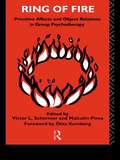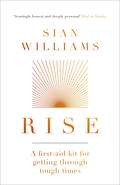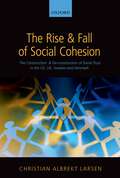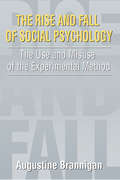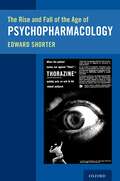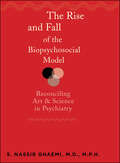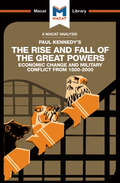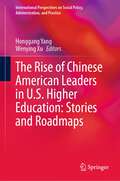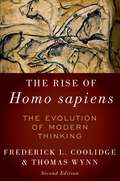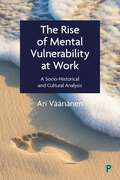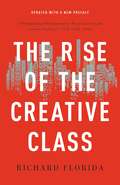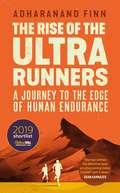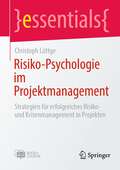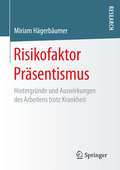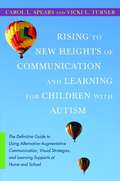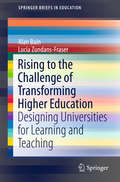- Table View
- List View
Ring of Fire: Primitive affects and object relations in group Psychotherapy (The International Library of Group Psychotherapy and Group Process)
by Malcolm Pines Victor SchermerFirst published in 1994. Routledge is an imprint of Taylor & Francis, an informa company.
Ring of Fire: Primitive affects and object relations in group Psychotherapy (The International Library of Group Psychotherapy and Group Process)
by Victor L. Schermer Malcolm Pines Otto KernbergFirst published in 1994. Routledge is an imprint of Taylor & Francis, an informa company.
Rise: A first-aid kit for getting through tough times
by Sian Williams'A week after my 50th birthday and just as our family was about to move home, something happened that changed the way I looked at life. I spoke to others about how they rebuilt their shattered worlds after very different personal traumas, emerging stronger than before. I hope our experiences, together with the latest science on resilience, will help guide all those going through tough times. This book says that it's possible not just to survive them, but to thrive. To rise.'Renowned as a much-loved and highly respected journalist and broadcaster with thirty years' experience, Sian Williams has studied the impact of acute stress for many years and is also a trained trauma assessor.In RISE, she explores the science of resilience and growth after trauma, offers advice from the experts, and learns from those who have emerged from horrific experiences, feeling changed yet stronger, with a new perspective on their life, their relationships and their work. She also documents her own path through breast cancer, with candid and unflinching honesty. Her story provides a narrative thread through a book designed to help others deal with all manner of adversity, including physical or mental ill health; loss of a loved one; abuse and post-traumatic stress.RISE is a deeply researched exploration of trauma, grief and illness, and most importantly resilience in the darkest of days. It is an inspiring and powerful piece of work, full of honesty, warmth and wisdom.
The Rise And Fall Of Social Cohesion: The Construction And De-construction Of Social Trust In The Us, Uk, Sweden And Denmark
by Christian Albrekt LarsenThe book explores the ways in which social cohesion — measured as trust in unknown fellow citizens — can be established and undermined. It examines the US and UK, where social cohesion declined in the latter part of the twentieth century, and Sweden and Denmark, where social cohesion increased, and aims to put forward a social constructivist explanation for this shift. Demonstrating the importance of public perceptions about living in a meritocratic middle class society, the book argues that trust declined because the Americans and British came to believe that most other citizens belong to an untrustworthy, undeserving, and even dangerous 'bottom' of society rather than to the trustworthy middle classes. In contrast, trust increased amongst Swedes and Danes as they believed that most citizens belong to the 'middle' of society rather than to the 'bottom'. Furthermore, the Swedes and Danes came to view the (perceived) narrow 'bottom' of their society as trustworthy, deserving, and peaceful. The book argues that social cohesion is primarily a cognitive phenomenon, in contrast to previous research, which has emphasized the presence of shared moral norms, fair institutions, networks, engagement in civil society etc. The book is based on unique empirical data material, where American survey items have been replicated in the British Social Attitude survey and the Danish and Swedish ISSP surveys (exclusively for this book). It also includes a unique cross-national study of media content covering a five year period in UK, Sweden, and Denmark. It demonstrates how 'the bottom' and 'the middle' is differently constructed across countries.
The Rise and Fall of Social Psychology: An Iconoclast's Guide to the Use and Misuse of the Experimental Method (Social Problems And Social Issues Ser.)
by Augustine BranniganThis unflinching effort critically traces the attempt of social psychology over the past half century to forge a scientific understanding of human behavior based on the systematic use of experiments.Having examined the record from the inception of the field to the present, Brannigan suggests that it has failed to live up to its promise: that social psychologists have achieved little consensus about the central problems in the field; that they have failed to amass a body of systematic, non-trivial theoretical insight; and that recent concerns over the ethical treatment of human subjects could arguably bring the discipline to closure. But that is not the disastrous outcome that Brannigan hopes for. Rather, going beyond an apparent iconoclasm, the author explores prospects for a post-experimental discipline. It is a view that admits the role of ethical considerations as part of scientific judgment, but not as a sacrifice of, but an extension of, empirical research that takes seriously how the brain represents information, and how these mechanisms explain social behaviors and channel human choices and appetites.What makes this work special is its function as a primary text in the history as well as the current status of social psychology as a field of behavioral science. The keen insight, touched by the gently critical styles, of such major figures as Philip Zimbardo, Morton Hunt, Leon Festinger, Stanley Milgram, Alex Crey, Samuel Wineburg, Carol Gilligan, David M. Buss--among others--makes this a perfect volume for students entering the field, and no less, a reminder of the past as well as present of social psychology for its serious practitioners.
The Rise and Fall of Social Psychology: An Iconoclast's Guide to the Use and Misuse of the Experimental Method
by Augustine BranniganThis unflinching effort critically traces the attempt of social psychology over the past half century to forge a scientific understanding of human behavior based on the systematic use of experiments.Having examined the record from the inception of the field to the present, Brannigan suggests that it has failed to live up to its promise: that social psychologists have achieved little consensus about the central problems in the field; that they have failed to amass a body of systematic, non-trivial theoretical insight; and that recent concerns over the ethical treatment of human subjects could arguably bring the discipline to closure. But that is not the disastrous outcome that Brannigan hopes for. Rather, going beyond an apparent iconoclasm, the author explores prospects for a post-experimental discipline. It is a view that admits the role of ethical considerations as part of scientific judgment, but not as a sacrifice of, but an extension of, empirical research that takes seriously how the brain represents information, and how these mechanisms explain social behaviors and channel human choices and appetites.What makes this work special is its function as a primary text in the history as well as the current status of social psychology as a field of behavioral science. The keen insight, touched by the gently critical styles, of such major figures as Philip Zimbardo, Morton Hunt, Leon Festinger, Stanley Milgram, Alex Crey, Samuel Wineburg, Carol Gilligan, David M. Buss--among others--makes this a perfect volume for students entering the field, and no less, a reminder of the past as well as present of social psychology for its serious practitioners.
The Rise and Fall of the Age of Psychopharmacology
by Edward ShorterThe Age of Psychopharmacology began with a brilliant rise in the 1950s, when for the first time science entered the study of drugs that affect the brain and mind. But, esteemed historian Edward Shorter argues that there has been a recent fall, as the field has seen its drug offerings impoverished and its diagnoses distorted by the "Diagnostic and Statistical Manual of Mental Disorders." The new drugs, such as Prozac, have been less effective than the old. The new diagnoses, such as "major depression," have strayed increasingly from the real disorders of most patients. Behind this disaster has been the invasion of the field by the pharmaceutical industry. This invasion has paid off commercially but not scientifically: There have been no new classes of psychiatry drugs in the last thirty years. Given that psychiatry's diagnoses and therapeutics have largely failed, the field has greatly declined from earlier days. Based on extensive research discovered in litigation, Shorter provides a historical perspective of change and decline over time, concluding that the story of the psychopharmacology is a story of a public health disaster.
The Rise and Fall of the Age of Psychopharmacology
by Edward ShorterThe Age of Psychopharmacology began with a brilliant rise in the 1950s, when for the first time science entered the study of drugs that affect the brain and mind. But, esteemed historian Edward Shorter argues that there has been a recent fall, as the field has seen its drug offerings impoverished and its diagnoses distorted by the "Diagnostic and Statistical Manual of Mental Disorders." The new drugs, such as Prozac, have been less effective than the old. The new diagnoses, such as "major depression," have strayed increasingly from the real disorders of most patients. Behind this disaster has been the invasion of the field by the pharmaceutical industry. This invasion has paid off commercially but not scientifically: There have been no new classes of psychiatry drugs in the last thirty years. Given that psychiatry's diagnoses and therapeutics have largely failed, the field has greatly declined from earlier days. Based on extensive research discovered in litigation, Shorter provides a historical perspective of change and decline over time, concluding that the story of the psychopharmacology is a story of a public health disaster.
The Rise and Fall of the Biopsychosocial Model: Reconciling Art and Science in Psychiatry
by S. Nassir GhaemiThis is the first book-length historical critique of psychiatry’s mainstream ideology, the biopsychosocial (BPS) model. Developed in the twentieth century as an outgrowth of psychosomatic medicine, the biopsychosocial model is seen as an antidote to the constraints of the medical model of psychiatry. Nassir Ghaemi details the origins and evolution of the BPS model and explains how, where, and why it fails to live up to its promises. He analyzes the works of its founders, George Engel and Roy Grinker Sr., traces its rise in acceptance, and discusses its relation to the thought of William Osler and Karl Jaspers. In assessing the biopsychosocial model, Ghaemi provides a philosophically grounded evaluation of the concept of mental illness and the relation between evidence-based medicine and psychiatry. He argues that psychiatry's conceptual core is eclecticism, which in the face of too much freedom paradoxically leads many of its adherents to enact their own dogmas. Throughout, he makes the case for a new paradigm of medical humanism and method-based psychiatry that is consistent with modern science while incorporating humanistic aspects of the art of medicine.Ghaemi shows how the historical role of the BPS model as a reaction to biomedical reductionism is coming to an end and urges colleagues in the field to embrace other, less-eclectic perspectives.
The Rise and Fall of the Great Powers: Economic Change and Military Conflict From 1500-2000 (The Macat Library)
by Riley QuinnPaul Kennedy owes a great deal to the editor who persuaded him to add a final chapter to this study of the factors that contributed to the rise and fall of European powers since the age of Spain’s Philip II. This tailpiece indulged in what was, for an historian, a most unusual activity: it looked into the future. Pondering whether the United States would ultimately suffer the same decline as every imperium that preceded it, it was this chapter that made The Rise and Fall of the Great Powers a dinner party talking point in Washington government circles. In so doing, it elevated Kennedy to the ranks of public intellectuals whose opinions were canvassed on matters of state policy. From a strictly academic point of view, the virtues of Kennedy's work lie elsewhere, and specifically in his flair for asking the sort of productive questions that characterize a great problem-solver. Kennedy's work is an example of an increasingly rare genre – a work of comparative history that transcends the narrow confines of state– and era–specific studies to identify the common factors that underpin the successes and failures of highly disparate states. Kennedy's prime contribution is the now-famous concept of ‘imperial overstretch,’ the idea that empires fall largely because the military commitments they acquire during the period of their rise ultimately become too much to sustain once they lose the economic competitive edge that had projected them to dominance in the first place. Earlier historians may have glimpsed this central truth, and even applied it in studies of specific polities, but it took a problem-solver of Kennedy's ability to extend the analysis convincingly across half a millennium.
The Rise and Fall of the Great Powers: Economic Change and Military Conflict From 1500-2000 (The Macat Library)
by Riley QuinnPaul Kennedy owes a great deal to the editor who persuaded him to add a final chapter to this study of the factors that contributed to the rise and fall of European powers since the age of Spain’s Philip II. This tailpiece indulged in what was, for an historian, a most unusual activity: it looked into the future. Pondering whether the United States would ultimately suffer the same decline as every imperium that preceded it, it was this chapter that made The Rise and Fall of the Great Powers a dinner party talking point in Washington government circles. In so doing, it elevated Kennedy to the ranks of public intellectuals whose opinions were canvassed on matters of state policy. From a strictly academic point of view, the virtues of Kennedy's work lie elsewhere, and specifically in his flair for asking the sort of productive questions that characterize a great problem-solver. Kennedy's work is an example of an increasingly rare genre – a work of comparative history that transcends the narrow confines of state– and era–specific studies to identify the common factors that underpin the successes and failures of highly disparate states. Kennedy's prime contribution is the now-famous concept of ‘imperial overstretch,’ the idea that empires fall largely because the military commitments they acquire during the period of their rise ultimately become too much to sustain once they lose the economic competitive edge that had projected them to dominance in the first place. Earlier historians may have glimpsed this central truth, and even applied it in studies of specific polities, but it took a problem-solver of Kennedy's ability to extend the analysis convincingly across half a millennium.
The Rise of Chinese American Leaders in U.S. Higher Education: Stories and Roadmaps (International Perspectives on Social Policy, Administration, and Practice)
by Honggang Yang Wenying XuThis book is a collection of stories and reflections that represent Chinese American leaders and depict their tortuous journeys in U.S. higher education that comes at a critical point in time. Many books have been devoted to academic leadership, but this volume uniquely focuses on subjects most relevant to Chinese Americans. We live at a time that not only witnesses an increase in Chinese American leaders on U.S. campuses but also mounting incidents of discriminatory treatment of this group. This book showcases 36 stories and reflections from past, present, and future leaders, including the five previously published stories. They represent leaders holding different ideological values in various academic fields, positions, stages of careers, professional trajectories, generations, Chinese ethnic groups, and geographical locations. The Rise of Chinese American Leaders in U.S. Higher Education makes a valuable contribution to the body of literature that has assisted countless academic leaders in navigating their careers, bringing to the forefront a distinct group of academic leaders who have been underrepresented.
The Rise of Homo Sapiens: The Evolution of Modern Thinking
by Frederick L. Coolidge Thomas WynnThe Rise of Homo sapiens provides an unrivalled interdisciplinary introduction to the subject of hominin cognitive evolution that is appropriate for general audiences and students in psychology, archaeology, and anthropology. The book includes chapters on neural anatomy, working memory, evolutionary methods, and non-human primate cognition, but the bulk of the text reviews major developments in cognition over the span of hominin evolution from the ape-like cognition of Ardipithecus to the final developments that enabled the modern mind. The most provocative chapters of the first edition - the explicit discussion of the role of sleep in hominin evolution and the difference between Neandertal and modern human cognition - incorporate significant developments in both areas since the publication of the first edition. This revised edition updates the former text and adds greater emphasis to the growing fields of epigenetic inheritance, embodied cognition, and neuroaesthetics. The new edition provides greater emphasis on role and status of Homo heidelbergensis.
The Rise of Homo Sapiens: The Evolution of Modern Thinking
by Thomas Wynn Frederick L. CoolidgeThe Rise of Homo sapiens provides an unrivalled interdisciplinary introduction to the subject of hominin cognitive evolution that is appropriate for general audiences and students in psychology, archaeology, and anthropology. The book includes chapters on neural anatomy, working memory, evolutionary methods, and non-human primate cognition, but the bulk of the text reviews major developments in cognition over the span of hominin evolution from the ape-like cognition of Ardipithecus to the final developments that enabled the modern mind. The most provocative chapters of the first edition - the explicit discussion of the role of sleep in hominin evolution and the difference between Neandertal and modern human cognition - incorporate significant developments in both areas since the publication of the first edition. This revised edition updates the former text and adds greater emphasis to the growing fields of epigenetic inheritance, embodied cognition, and neuroaesthetics. The new edition provides greater emphasis on role and status of Homo heidelbergensis.
The Rise of Mental Vulnerability at Work: A Socio-Historical and Cultural Analysis
by Ari VäänänenSince the 1960s, a major mental health crisis has emerged among Western working populations. By analysing the development of various occupational cultures and using extensive data sources, this book captures the history of mental vulnerability in working life. Through a study spanning several decades, the book develops a new understanding of how mental vulnerability has evolved through changes to our working lives and socio-cultural being. It shows how our current knowledge about work, disability and the psyche is influenced by our time and provides intertwining conceptual frameworks and alternatives to current canonised knowledge about mental health in working life.
The Rise of Mental Vulnerability at Work: A Socio-Historical and Cultural Analysis
by Ari VäänänenSince the 1960s, a major mental health crisis has emerged among Western working populations. By analysing the development of various occupational cultures and using extensive data sources, this book captures the history of mental vulnerability in working life. Through a study spanning several decades, the book develops a new understanding of how mental vulnerability has evolved through changes to our working lives and socio-cultural being. It shows how our current knowledge about work, disability and the psyche is influenced by our time and provides intertwining conceptual frameworks and alternatives to current canonised knowledge about mental health in working life.
The Rise of the Creative Class: Revised And Expanded
by Richard FloridaWorld-renowned urbanist Richard Florida's bestselling classic on the transformation of our cities in the twenty-first century -- now updated with a new preface In his modern classic The Rise of the Creative Class, urbanist Richard Florida identifies the emergence of a new social class reshaping the twenty-first century's economy, geography, and workplace. This Creative Class is made up of engineers and managers, academics and musicians, researchers, designers, entrepreneurs and lawyers, poets and programmer, whose work turns on the creation of new forms. Increasingly, Florida observes, this Creative Class determines how workplaces are organized, which companies prosper or go bankrupt, and which cities thrive, stagnate or decline. Florida offers a detailed occupational, demographic, psychological, and economic profile of the Creative Class, examines its global impact, and explores the factors that shape "quality of place" in our changing cities and suburbs. Now updated with a new preface that considers the latest developments in our changing cities, The Rise of the Creative Class is the definitive edition of this foundational book on our contemporary economy.
The Rise of the Ultra Runners: A Journey to the Edge of Human Endurance
by Adharanand Finn*Shortlisted for the 2019 William Hill Sports Book of the Year*Marathons are no longer enough. Pain is to be relished, not avoided. Hallucinations are normal.Ultra running defies conventional logic. Yet this most brutal and challenging sport is now one of the fastest-growing in the world. Why is this? Is it an antidote to modern life, or a symptom of a modern illness?Adharanand Finn travelled to the heart of the sport to find out - and to see if he could become an ultra runner himself. His journey took him from the deserts of Oman to the snow-capped peaks of the Rockies, and on to his ultimate goal, the 105-mile Ultra-Trail du Mont-Blanc.The Rise of the Ultra Runners is the electrifying, inspirational account of what he learned along the way. Through encounters with the sport's many colourful characters and his experiences of its soaring highs and crushing lows, Finn offers an unforgettable insight into what can be found at the boundaries of human endeavour.
Risiko-Psychologie im Projektmanagement: Strategien für erfolgreiches Risiko- und Krisenmanagement in Projekten (essentials)
by Christoph LüttgeNichts im Leben und im Projektmanagement geht genau nach Plan. Immer wieder machen uns äußere Ereignisse und Entwicklungen einen Strich durch die Rechnung. Deshalb ist die nüchterne Analyse von Risiken und die Vorbereitung auf entsprechende Krisen ein Schlüsselelement erfolgreichen Projektmanagements. Dem stehen jedoch psychologische Faktoren entgegen. Welche Faktoren dies sind und woher diese kommen und wie man damit umgeht, darauf gibt es Antworten in diesem Buch und dem inkludierten Online Kurs.
Risikofaktor Präsentismus: Hintergründe und Auswirkungen des Arbeitens trotz Krankheit
by Miriam HägerbäumerProf. Dr. Miriam Hägerbäumer beleuchtet das als Präsentismus bezeichnete Phänomen des Arbeitens trotz Krankheit hinsichtlich seiner Ursachen und Folgen und entwickelt hierzu ein valides Messinstrument. Mit einem Überblick zum Thema Gesundheit und Krankheit im beruflichen Kontext schafft die Autorin die Grundlage für das Verständnis der Komplexität des Präsentismus. Sie führt theoretische Annahmen und empirische Befunde zu einem integrativen Wirkmodell zusammen und leitet aus diesen Ergebnissen Handlungsempfehlungen für das betriebliche Gesundheitsmanagement sowie für die Forschung zu dieser gesundheitsrelevanten Copingstrategie ab.
Risikoverhalten und Selbstregulation bei Jugendlichen: Eine kybernetische Sichtweise
by Franz Resch Peter ParzerDiesem Buch liegt der Gedanke zugrunde, dass zunehmende jugendliche Risikoverhaltensweisen - wie Drogenmissbrauch, nicht-suizidale Selbstverletzung und antisoziales oder suizidales Verhalten - es Heranwachsenden ermöglichen, Entwicklungsaufgaben wie Identitätsbildung und Selbstwertregulation zu erfüllen. Narzisstische Selbstausbeutung, Mobilitätsaufgaben, Flexibilität und die Herausforderungen der neuen Medien üben sozialen Druck auf die Eltern aus, lenken ab und belasten ihre psychischen Ressourcen, was wiederum den emotionalen Dialog mit ihren Kindern verändert oder gar zerstört. Erleben Kinder selbst Vernachlässigung und mangelnde emotionale Bindung - und damit fehlende Selbstregulationsfähigkeit - sind Risikoverhaltensweisen die Folge.Das Buch kombiniert verschiedene Sichtweisen aus dem psychologischen, sozialen und metatheoretischen Bereich. Es besteht aus drei Teilen: Entwicklungsprobleme junger Menschen, Diagnose von Risikoverhaltensweisen im nosologischen Rahmen und Darstellung der neuen Morbidität mit einer Zunahme der Symptomprävalenz. Das Buch erörtert auch die Bedrohung durch die Beschleunigung der sozialen Prozesse und die Risiken der postmodernen Gesellschaft.
Risikowahrnehmung bezüglich der Infektionsgefahr von Covid-19: Untersuchung zum unrealistischen Optimismus unter Verwendung sozialer Dilemmata (BestMasters)
by Philipp ErtelDie Corona-Pandemie hat gezeigt, dass die Gefahr, sich selbst und andere mit einem bedrohlichen Virus anzustecken, zu einer Vielzahl sozialer Dilemma-Situationen im Alltag führt. Das vorliegende Buch geht der sozialpsychologischen Frage nach, wie Menschen das Risiko einer Covid-19-Infektion in konkreten Dilemma-Situationen für sich selbst und für eine andere Person einschätzen. Dabei wird der Fokus auf die Differenz zwischen der selbst- und fremdbezogen Risikowahrnehmung sowie zwischen der selbstbezogenen Risikowahrnehmung und der objektiven Risikobeurteilung mittels eines Algorithmus gelegt. Diese Differenz wird in der Risikoforschung als unrealistischer Optimismus/Pessimismus bezeichnet. Neben der Beleuchtung des aktuellen Forschungsstands wird die Risikowahrnehmung und das Auftreten des unrealistischen Optimismus/Pessimismus im Rahmen einer Querschnittsstudie anhand von drei fiktiven, aber realitätsnahen Dilemma-Szenarien aus dem Corona-Kontext untersucht und diskutiert.
Rising to New Heights of Communication and Learning for Children with Autism: The Definitive Guide to Using Alternative-Augmentative Communication, Visual Strategies, and Learning Supports at Home and School
by Carol Spears Vicki TurnerChildren with pervasive developmental disorders often do not learn from conventional methods, which can result in social isolation, behavior problems, limitations in communication, and slow academic growth. Greater integration into home and school activities, improved behavior and academic success can be achieved using alternative-augmentative communication (AAC), and this book explains exactly how to make it happen. Exploring the various communication and intervention options available and offering straightforward techniques and strategies for using them effectively, this book clearly explains everything families, teachers, therapists and other professionals need to know in order to improve a child's communication, behavior, social and academic skills. Chapters follow a consistent, user-friendly format, answering the questions Who, What, Why, How, Where and When about every technique. This book will be essential reading for anyone looking to improve social interaction between children with pervasive developmental disorders and those around them.
Rising to New Heights of Communication and Learning for Children with Autism: The Definitive Guide to Using Alternative-Augmentative Communication, Visual Strategies, and Learning Supports at Home and School (PDF)
by Carol Spears Vicki TurnerChildren with pervasive developmental disorders often do not learn from conventional methods, which can result in social isolation, behavior problems, limitations in communication, and slow academic growth. Greater integration into home and school activities, improved behavior and academic success can be achieved using alternative-augmentative communication (AAC), and this book explains exactly how to make it happen. Exploring the various communication and intervention options available and offering straightforward techniques and strategies for using them effectively, this book clearly explains everything families, teachers, therapists and other professionals need to know in order to improve a child's communication, behavior, social and academic skills. Chapters follow a consistent, user-friendly format, answering the questions Who, What, Why, How, Where and When about every technique. This book will be essential reading for anyone looking to improve social interaction between children with pervasive developmental disorders and those around them.
Rising to the Challenge of Transforming Higher Education: Designing Universities for Learning and Teaching (SpringerBriefs in Education #0)
by Alan Bain Lucia Zundans-FraserCreating a successful and distinctive approach to learning and teaching at scale is a challenge facing all universities. This brief presents the Self-Organizing University (SOU), a transformational whole-of-organization solution for the design, delivery, and evaluation of learning and teaching in all its forms. It describes the elements of the SOU approach along with the implementation process and expected outcomes. It also explains the rationale and research base for each element of the model and how they are connected to create a university-wide model of learning and teaching. It includes guidance for anyone responsible for institutional improvement in the learning and teaching space.
